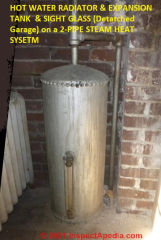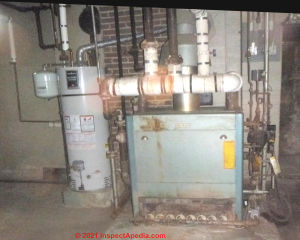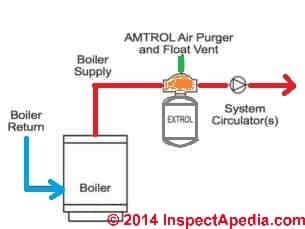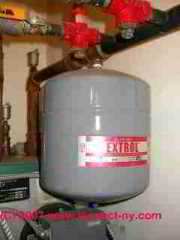 Guide to Heating Boiler Expansion Tanks
Guide to Heating Boiler Expansion Tanks
How to troubleshoot, drain, or service & repair the expansion tank (compression tank) on hot water heating systems
- POST a QUESTION or COMMENT about heating system expansion tanks: their function, size, location, maintenance, and need for draining (on some models)
Hot water heating system expansion tank / compression tank installation, troubleshooting, repair:
How to identify, inspect, install, repair, or service heating boiler expansion tanks: here we explain the function of expansion tanks on hot water (hydronic) heating systems.
We discuss what happens if the expansion tank becomes waterlogged, how to drain a waterlogged expansion tank, and what sorts of expansion tanks, like the one shown at page top, should never become waterlogged.
We describe where the expansion tank may be found (sometimes in the attic!) and we illustrate different sorts of expansion tanks used over the history of hydronic heating in buildings. In this article series we provide a heating system expansion tank / compression tank Troubleshooting & Repair Guide that will address just about any problem traced to this heating system component.
InspectAPedia tolerates no conflicts of interest. We have no relationship with advertisers, products, or services discussed at this website.
- Daniel Friedman, Publisher/Editor/Author - See WHO ARE WE?
Heating Boiler Expansion Tanks - Troubleshoot, Understand, Fix
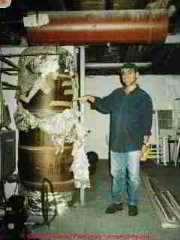 The photo at page top shows a modern Extrol(R) bladder-type heating system expansion tank. At left over our client's head is a reddish tan steel heating boiler expansion tank (or compression tank in some texts).
The photo at page top shows a modern Extrol(R) bladder-type heating system expansion tank. At left over our client's head is a reddish tan steel heating boiler expansion tank (or compression tank in some texts).
In detailed articles listed at the end of this page our information on hot water heating system expansion tanks includes:
How to Drain an Expansion Tank
- Troubleshooting & Repair Guide: Diagnostic Tests for Waterlogged Heating Boiler Expansion Tank
- How to troubleshoot an internal-bladder type expansion tank or How to troubleshoot a traditional bladderless expansion tank or compression tank.
How to diagnose trouble with internal bladder Extrol type expansion tanks - What goes wrong with bladderless expansion tanks - waterlogging & its causes
[Click to enlarge any image]
What is a Heating Boiler Expansion Tank & How Do Expansion Tanks Work
Heating boiler expansion tanks are metal tanks of varying sizes that are installed to absorb the initial pressure increase that occurs when the heating boiler system warms up.
Air molecules entrained in water inside the heating boiler itself as well as in the heating system piping, baseboards, or radiators, expand and thus cause an initial pressure increase in the heating system.
That pressure is increase is absorbed by allowing water from the heating system to squash or compress a reservoir of air inside the expansion tank - which is why some heating experts call our expansion tank a "compression tank".
Inside of a working expansion tank is a reserve space of air. In fact, when the heating boiler and system are cool, the traditional bladderless boiler expansion tank will contain mostly air.
 Or in newer smaller internal bladder type expansion/compression tanks an internal rubber bladder keeps air separated from the heating system's water - avoiding rapid loss of air by absorption into the heating systems' water.
Or in newer smaller internal bladder type expansion/compression tanks an internal rubber bladder keeps air separated from the heating system's water - avoiding rapid loss of air by absorption into the heating systems' water.
As the heating system warms up and as air entrained in the water raises system pressure, the increased pressure forces some of the heating system water into the expansion tank, squashing its air-charge into a smaller volume, thus permitting the tank to absorb the initial increase in system pressure.
Technical note: the water and air inside the expansion tank will always share the same pressure, but since water is not (very) compressible and air is, the increase in pressure will squeeze the air down to a smaller volume.
That's why some heating system water can pass into the expansion tank.
If heating system pressures and/or temperatures exceed normal (for a residential heating boiler that would be a pressure above 30 psi or a temperature much above 200 °F) then the expansion tank is dismissed from duty and the pressure/temperature relief valve on the boiler will open to provide emergency relief.
What Happens if the Expansion / Compression Tank is Not Working?
The loss of air cushion in the expansion / compression tank means that at each heating-on cycle the system pressure can be too high, causing the temperature/pressure relief valve to spill.
See RELIEF VALVE LEAKS for a catalog of causes of TPR valve leaks.
Watch out: if you see water dripping or squirting out of the temperature/pressure relief valve on any vessel, such as a hydronic heating boiler, the situation is unsafe.
The valve may be doing its job of relieving excessive pressure or temperature, but there is a risk that the valve becomes clogged by mineral deposits or crud left by the escaping water. A clogged TPR valve is no longer protecting the system from an explosion
See details at BLEVE EXPLOSIONS
A second problem with older expansion/compression tanks - those that do not use an internal bladder to keep water and air separate, is the loss of air out of the compression tank and into the heating system water. We won't like the result.
Why do we care about keeping air out of the heating system water?
Air in the hot water heating system can cause loss of heat: air in baseboards radiators keeps hot water out - they don't get hot. And air in hot water heating system piping can simply keep hot water from ever reaching the radiators or baseboards.
Details are at AIR-BOUND HEATING SYSTEMS
See HOT WATER PRESSURE EXPANSION RATE if you're feeling curious about the physics involved in the pressure increase as we heat up water,
How & Why do Expansion Tanks Get Waterlogged?
 Loss of Air Charge in a Bladderless Steel Traditional Heating System Expansion Tank
Loss of Air Charge in a Bladderless Steel Traditional Heating System Expansion Tank
In older hot water heating boiler expansion tanks that do not have an internal bladder to keep air and water separate, over time air in the expansion tank may become absorbed into the heating water.
Air may also find its way via the heating water to other air bleeders or vents in the system.
As air is lost and water just stays in the expansion tank, the space and pressure cushion provided by air in the expansion tank gets too small, or is lost entirely.
There is no more air cushion to absorb initial pressure increases in the heating system during each heating boiler on-cycle.
Loss of Air Charge in an Internal-Bladder-Type Heating System Expansion Tank
In a modern internal-bladder type expansion tank use on heating systems it is not usually necessary to add air nor to change the tank pressure. There are however several sources of loss of the air charge and causes of water logging in an internal bladder-type expansion tank:
- Expansion tank bladder rupture:
Occasionally the internal bladder of these tanks an rupture, leading rather quickly, perhaps in less than a single heating season, to a water-logged expansion tank tank. In that case the symptom may be observing that heating system pressure relief valve may spill or water may be found leaking out at the expansion tank's air pressure adjustment valve.
See this field report: RELIEF VALVE LEAK DUE TO EXPANSION TANK that traces a leaky relief valve to a failed expansion vessel on a Cosmogas boiler. - Expansion tank pinhole leak:
Occasionally a pinhole leak develops in the internal bladder of an expansion tank. We first received reports of this subtle failure from readers reporting on waterlogged water supply system pressure tanks.
The pinhole leak is almost impossible to observe even if you cut apart the tank to remove and inspect the rubber tank bladder or diaphragm.
Rather the symptom shows up as a slow loss of tank volume that can result in cyclic leaking at the heating systems TPR valve.
Since other heating system problems such as water hammer can also cause sporadic TPR valve leaks or drips this defect can be hard to track down.
On water supply system tanks we may observe an increase in the air pressure of the tank above its initial charge, measured at its pressure valve, even when there is no water pressure on the system.
That's because water has leaked into the air space, reducing the available volume for air and thus permanently increasing the pressure therein. Remember from your gas laws that P1V1 = P2V2? If we reduce the air volume the pressure must increase. - Expansion tank membrane permeability:
Reader NJT, Holohan, and several other sources cited atReferences or Citations note that a bladder-type hydronic heating expansion tank may lose air pressure at about 1 psi per year as air passes through the tank membrane and into the heating system's hot water.
Considering that heating system pressures and temperatures are cycling constantly during the heating season, one may speculate that the unidirectional movement of air from the tank through its bladder and into the heating water would have to be occurring when system pressures are highest.
Hydronic (hot water) Heating Loops on Steam Heating Systems
Boiler Expansion Tank + Sight Glass on a Steam Heating Sysetm?
Why do we find this expansion tank and sight glass connected to a steam heating system?
[Click to enlarge any image]
The mystery is easily explained by noting that some steam heating systems, including the Weil McLain gas fired steam boiler below, are also used to provide hot water or hydronic heat to some building areas or even to a separate outbuilding where it is easier to circulate hot water than to route and control steam piping.
Why the sight glass on this expansion tank? Because it's not just handling expansion; the tank's water level assures occupants that there is sufficient water reservoir in the sysetm for the hydronic loop off of the steam boiler to actually provide heat.
Typically a separate circuator pump and hot water piping loop are connected to the lower, wet portion of the steam boiler and are used to supply hot water to one or more hot water radiators or convectors elsewhere in the building or property.
Above is the Weil McLain gas fired two pipe steam heating system boiler whose hot water feeds a separate hot water radiator and expansion tank with sight glass located in a separate garage on the same property. Photos courtesy of Pennsylvania home inspector Lawrence Transue.
More about steam heating systems can be found
at STEAM HEATING SYSTEMS & CONTROLS - home
- Lawrence Transue is a Pennsylvania building scientist and consultant, a certified ASHI home inspector, a Licensed Pesticide Applicator, a
BPI Building Analyst & Envelope Professional, with
18 Years of Home Inspection Experience. He can be reached by Telephone: 610.417.0763, by Email: lawrence@lawrencetransue.com as well as at his WEBSITE and at FACEBOOK.
Mr. Transue is a frequent contributor to InspectAPedia.com.
Boiler Expansion Tank Installation & Operation Manuals, Guides, Standards
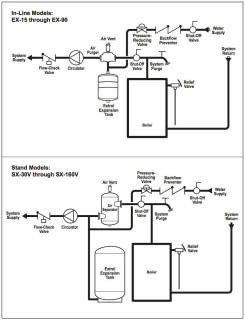 Illustration: an example guide showing the location of two types of expansion tanks, excerpted from Amtrol's Extrol instructions from 2014, cited in detail below.
Illustration: an example guide showing the location of two types of expansion tanks, excerpted from Amtrol's Extrol instructions from 2014, cited in detail below.
- AMTROL's EXTROL®, the FILL-TROL® REPAIR GUIDE - [Web article, in-depth w/ more citations & documents for Amtrol Extrol expansion tanks used on heating systems]
- AMTROL, EXTROL® EXPANSION TANKS INSTALLATION & OPERATION INSTRUCTIONS EX-SX [PDF] (2016) Models EX-15 - EX-90, Models SX-30V - SC-160V, Extrol Corporation, 1400 Division Road, West Warwick RI 02983, Tel: 401-884-6300, Website: www.amtrol.com, retrieved 2018/08/03, original source: https://www.amtrol.com/wp-content/uploads/2017/04/9015-941-10_16-Extrol-IO-w_InSight-Cap.pdf
- AMTROL EXTROL® EXPANSION TANKS IO INSTRUCTIONS EX-15-90, SX 30V-160VSeries [PDF] (2014) Models EX-15 - EX-90, Models SX-30V - SC-160V,
- AMTROL EXTROL® EXPANSION TANKS IO MANUAL SX-Series [PDF] (2003) In-Line & SX-Series EXTROL Expansion Tank instructions, retrieved 2018/08/03, original source: https://www.sunsourceproducts.com/library/documents/Amtrol-Extrol-InstallOperation.pdf
- AMTROL FILL-TROL® EXPANSTION TANK IO MANUAL FT-109 - FT111 [PDF] (2014) Models FT-109 - FT-111, Amtrol, Inc., retrieved 2018/08/03, original source: http://www.amtrol.com/wp-content/uploads/2017/05/9015026_06_14_FillTrol_IO-1.pdf
Excerpts from Amtrol's Fill-Trol Instructions: For Use In Closed Hydronic Systems Only
FILL-TROL® is a combination of an EXTROL® expansion tank and a specially designed automatic pressure reducing valve. Together, they manage water expansion to provide satisfactory heating system performance.
The EXTROL is pre-charged at the factory to 12 PSIG and is ready to install in most residential and light commercial systems without adjustment.
The valve is designed to fill the system with water and automatically shut off the flow when it reaches the precharge pressure in the tank. It will also restore the system to 12 PSIG if the pressure drops below that point.
The precharge may be changed to set the desired fill pressure. Do not install on domestic water systems, or in open heating systems. Corrosion and tank failure may result.
Use a Therm-X-Trol® or Therm-X-Span® for domestic water systems.
Use a Radiant EXTROL® for radiant heating systems where air elimination equipment or barrier tubing is not used. - Amtrol EXTROL SIZING GUIDE For Pressurization and Expansion Control of Low Temperature Water Systems [PDF] (2019) Amtrol, Worthington Industries, 1400 Division Road, West Warwick, RI USA 02893
T: 800.426.8765 www.amtrol.com - retrieved 2023/08/10, original source: amtrol [dot] com/wp-content/uploads/2019/06/9003-036-03_19-EXTROL-Sizing [dot] pdf
Excerpt:
The sizing methods, such as manufacturers’ selection tables and short cuts nomographs, which system designers may have used in the past, are at best, rule of thumb approximations only.
In many cases, the designer has used these methods to arrive at a general size range and then added their own safety margin to select a tank of larger size than originally calculated. While this practice has resulted in tanks sufficiently over-sized to include an adequate safety margin, it does not meet the critical sizing requirements that must be used in modern system design.
This data has been excerpted from the
AMTROL ENGINEERING HANBDBOOK [PDF] (1977, reprinted 2011) Chapter Two, Section B, “Hydro-pneumatics in Hot Water Heating Systems”. The complete handbook covers the application of hydro-pneumatics in heating, plumbing, cooling, water supply and commercial water heating systems.
- ARMSTRONG L-SERIES BLADDER EXPANSION TANK OPERATING INSTRUCTIONS [PDF] (2003), Armstrong Pumps Inc., 93 East Ave., North Notawanda NY USA, 14120, Tel: 716-693-8813, Website: www.armstrongpumps.com
or S.A. Armstrong Ltd., 23 Bertrand Ave. Toronto Ontario Canada M1L 2P3, Tel: 416-755-2291
or Armstrong Pumps Ltd., Peartree Road, Stanway, Colchester, Essex United Kingdom CO3 0LP Tel: +44 (0) 1206 579491
This tank uses a replacable internal tank bladder. - ARMSTRONG L-SERIES BLADDER EXPANSION TANK INSTALLATION MANUAL [PDF] (2000) top outlet, installation & operation instructions, includes instructions for changing the expansion tank's internal bladder. Armstrong fluid technology.com Op. Cit.
- Bell & Gossett AIRTROL® System Installation, Operating and Service Instructions, Bell & Gossett, 8200 N. Austin Ave., Morton Grove IL 60053, USA - Tel 847 966-3700 Fax 847 965-8379. Retrieved 8/9/2012, original source B&G, [copy on file as Airtrol_Installation_Manual.pdf linked in this reference]
- Bell & Gossett B&G PRESSURIZED EXPANSION TANKS (ASME) Series B, D, B-LA INSTRUCTION MANUAL [PDF] (2012) Bell & Gossett, Xylem Inc. 8200 N. Austin Avenue Morton Grove, Illinois 60053 USA Tel: (847) 966-3700 Website: www.xyleminc.com/brands/bellgossett
- Extrol Corporation, INSTALLATION & OPERATION INSTRUCTIONS, EXTROL (R) HYDRONIC DIAPHRAGM EXPANSION TANKS IN-LINE & SX-SERIES [PDF] (2011) Extrol Corporation, 1400 Division Road, West Warwick RI 02983, Tel: 401-884-6300, Website: www.amtrol.com, retrieved 3/3/2014, original source http://www.amtrol.com/media/documents/extrol/9015183_3_11_EXTROL_IO.pdf
- HONEYWELL EXPANSION TANK TK300-XPS MANUAL [PDF] (2006), Honeywell International, Inc., 1985 Douglas Drive North, Golden Valley, MN 55422 USA
or Honeywell Limited-Honeywell LimitÈe, 35 Dynamic Drive, Toronto, Ontario Canada M1V 4Z9
Website: customer.honeywell.com
- TACO EXPANSION TANK MANUAL CA-SERIES [PDF] (2014), Taco, Inc., 1160 Cranston St., Cranston RI 02920 USA, Tel: 401-942-2800,
or TACO (Canada), Ltd., 6180 Ordan Drive, Mississauga, Ontario Canada L5T 2B3 Tel: 905-564-9422 - TACO EXPANSION TANK BAG REPLACEMENT INSTRUCTIONS CA-EXP Series [PDF[ (2015) Op. Cit. , retrieved 2018/08/03, original source: http://www.taco-hvac.com/uploads/FileLibrary/402-013.pdf
Most Taco Expansion Tanks are available with either bladders or diaphragms so that water and air are permanently separated. - TACO EXPANSION TANK MANUAL CBX [PDF] (2013), Op. Cit., retrieved 2018/08/03, original source: http://www.taco-hvac.com/uploads/FileLibrary/402-020.pdf
- TACO EXPANAION TANK CBX BLADDER REPLACEMENT INSTRUCTIONS [PDF] (2004), Op. Cit., retrieved 2018/08/03, original source: http://www.taco-hvac.com/uploads/FileLibrary/402-090CBXExTankRep.pdf
How to repalce the internal bladder in a Taco CBX expansion tank. - TACO EXPANSION TANK CW INSTRUCTION SHEET [PDF] (2010), Op. Cit., retrieved 2018/08/03, original source: http://www.taco-hvac.com/uploads/FileLibrary/402-093.pdf
- TACO EXPANSION TANK CW EXP BLADDER REPLACEMENT INSTRUCTIONS [PDF] (2001), Op. Cit., retrieved 2018/08/03, original source: http://www.taco-hvac.com/uploads/FileLibrary/402-025.pdf
How to repace the bladder in a Taco CW EXP bladder type expansion tank
- TACO EXPANSION TANK CX INSTRUCTIONS [PDF] (2013), Op. Cit., retrieved 2018/08/03, original source: http://www.taco-hvac.com/uploads/FileLibrary/402-015.pdf
- TACO PS-Series EXPANSION TANKS are also available in plain-steel construction in a range of sizes.
- WATER WORKER EXPANSTION TANK INSTALLATION INSTRUCTIONS [PDF], Water Worker, Tel: 401-884-6300, Website: www.waterworkerdiy.com, sold at Lowes building supply stores, retrieved 2018/08/03, original source: http://pdf.lowes.com/installationguides/642031654595_install.pdf
- WATTS ET SERIES EXPANSION TANK INSTALLATION INSTRUCTIONS [PDF] (2008) Series ET, Models ET-15 - ET-160 (1/2" NPT for use with an air separator) & Model ET-90 (3/4" NPT) Watts Water Safety & Flow Control Products, 815 Chestnut St., No. Andover, MA 01845-6098 USA, Website: www.watts.com
or Watts, 5435 North Service Rd., Burlington, ONT. L7L 5H7 Canada, Website: www.wattscanada.ca
Excerpt:
Watts ET Series may be installed in a tee or any other suitable tapping in the heating system and can be installed in a vertical or horizontal position.
CAUTION: The tank must be properly supported in horizontal applications. Max. temperature 210°F (99ºC),Max. working pressure 60 psi - WATTS ET ETX EXPANSION TANK INSTALLATION INSTRUCTIONS [PDF] (2008) Series ETX, ETSX hot water heating system expansion tanks, Op. Cit.
Excerpt:
Series ETX may be installed in a tee or any other suitable tapping in the heating system and can be installed in a vertical or horizontal position. Series ETSX are floor models. - See additional citations atReferences or Citations
- Also see MANUALS & PARTS GUIDES - HVAC - home for manuals for HVAC equipment, all brands.
Research on permeability of rubber used in internal bladder-type heating system compression tanks or expansion tanks
- Bodell, Bruce R. "Distillation of saline water using silicone rubber membrane." U.S. Patent 3,361,645, issued January 2, 1968.
- Ciesielski, Andrew. An introduction to rubber technology. iSmithers Rapra Publishing, 1999.
- Fuller, James, and David M. Stedham. "Expansion tank with a predictive sensor." U.S. Patent 8,633,825, issued January 21, 2014.
- Martinello, Ermanno, and Mark Weih. "Membrane coating for a water pressurization Bladder." U.S. Patent Application 12/498,128, filed July 6, 2009.
- Stern, S. A., F. J. Onorato, and Charles Libove. "The permeation of gases through hollow silicone rubber fibers: Effect of fiber elasticity on gas permeability." AIChE Journal 23, no. 4 (1977): 567-578.
- Terashita, Fumihiro, Shingo Takagi, Shinzo Kohjiya, and Yasutoshi Naito. "Airtight butyl rubber under high pressures in the storage tank of CAES‐G/T system power plant." Journal of applied polymer science 95, no. 1 (2005): 173-177.
...
Reader Comments, Questions & Answers About The Article Above
Below you will find questions and answers previously posted on this page at its page bottom reader comment box.
Reader Q&A - also see RECOMMENDED ARTICLES & FAQs
On 2021-02-10 by (mod) - safety valve is poping off each time boiler kicks on
Ernest
Please use the search feature on this page to find our article series on
And you will see a catalog of the common causes of that problem.
Watch out: a leaking relief valve is unsafe.
Before replacing an expansion tank let's be sure the problem is the tank and not high pressure, high temperature, water hammer, or other causes of a leaky TPR valve.
And if your expansion tank is an older one that doesn't use an internal bladder the tank may simply need to be drained.
Also see RELIEF VALVE LEAK DUE TO EXPANSION TANK
To replace an old bladderless expansion tank most installers would go to a modern Extrol type tank that in fact uses an internal bladder.
Those cost around $60. U.S. + labor.
On 2021-02-09 by ERNEST CUPP
is 300 an average price for an expansion tank?
safety valve is poping off each time boiler kicks on, what is wrong?
On 2021-02-04 - by (mod) -
I'm so glad, thank you for the feedback. Do let me know what happens.
On 2021-02-04 by jack perry
Thank you. This helped me.
On 2021-02-03 - by (mod) - signs that no water is entering the expansion tank: what to try next
Okay so that's a helpful additional to town. It does sound as if water is not entering your tank.
You might try opening the tank drain anyway to see if by some odd circumstance it has become over pressurized with air at too high a pressure.
If that doesn't change the situation then I think we're back to your original surmise, that there is either a valve closed between tank and boiler or a section of piping or the tank inlet itself is blocked.
In That case I might simply replace it with a modern internal bladder type extrol tank
On 2021-02-03 by jack perry
Thank you for the response. The tank sounds completely empty when tapped and never gets warm.
On 2021-02-03 - by (mod) - old bladderless expansion tank won't let water enter
Jack
In normal use the expansion tank on a hot water heating system is never full - so the bottom of the tank gets hot but the upper tank, wher there should be air, stays cooler.
If the tank becomes waterlogged - loses its air charge - then we'll see dripping or discharge at the boiler temperature/pressure relief valve.
The tank might be waterlogged without being 100% full of water - this could be your case.
Watch out: So if your boiler TPR valve drips and the boiler temperature and pressure are at normal levels, you want to turn off the boiler, isolate the expansion tank and then drain all of the water out of it.
In the ARTICLE INDEX are more articles on diagnosing RELIEF VALVE LEAKS
On 2021-02-03 by jack perry
I have an old large bladderless steel traditional heating system expansion tank that semes to not allow water to enter.
The lower pipe going to the tank gets hot, but the upper part of the tank stays cool. I replaced temperature/pressure relief valve and it leaks water.
The boiler now makes a strange noise but still works. Ideas please.
On 2020-11-14 - by (mod) - some hot water zones don't get hot
Dave
If you are confident that the thermostat is calling for heat and the circulator runs or zone valve opens (or both)
then
Check the ARTICLE INDEX to find the diagnostics in AIRBOUND HEATING SYSTEMS
On 2020-11-14 by Dave
Baseboards in upstairs not getting heat downstairs is ok coal heat
On 2020-03-08 - by (mod) - why does my expansion tank always hold some water?
Indi
It's normal for the expansion tank on a hydronic or hot water heating system to contain some water.
Typically that take will be about half field. If the tank becomes completely filled then it can't do its job and it needs to be drained.
If you consider the way those tanks are operated and maintained we start with an empty tank at atmospheric pressure and then we feed it from the boiler which is going to be between 12 and 30 psi, so the air that was at atmospheric pressure in the tank is going to be compressed and some water from the heating system will enter the tank.
On 2020-03-07 by Indi
Why is my expansion tank retaining water
On 2020-01-15 - by (mod) - expansion tank on pellet stove not working
You'll want to review this question with the pellet stove manufacturer, Michael as there are life-safety implications (though subtle ones) if an expansion tank doesn't work (recurrent relief valve leaks, clogging, BLEVE explosion).
That worrying aside, the absence of an expansion tank would not in any direct way affect the temperature rise in the boiler.
The expansion tank's job (discussed in detail above on this page) is to absorb the initial pressure increase in a closed hot water heating system so as to avoid dumping the TPR valve.
On 2020-01-15 by Michael devlin
I have a pellet burner with an expansion tank but it is not working can this cause the temperature to rise to high
And cut out the burner
Expansion Tank Sizing Procedures

This article has moved to EXPANSION TANK SIZING GUIDE
Amtrol's Adapted Extrol®, the Fill-Trol® Diaphragm-Type Expansion Tank
This article section has been moved: see AMTROL's EXTROL®, the FILL-TROL®
Signs of Trouble with a Heating Boiler Expansion Tank
This content has moved to EXPANSION TANK DIAGNOSIS
How to Drain & Re-Charge the Air Needed in a Heating Boiler Expansion Tank, step by step
This topic has moved to EXPANSION TANK DRAIN & AIR RE-CHARGE
Can't Find the Expansion Tank?
This article section has been moved to FIND the EXPANSION TANK
Other Leaks Into Boilers Can Cause Over-Pressure in the Boiler & Relief Valve Leaks
Reader Question: I drained the expansion tank but the system pressure is still too high; high radiators in the house are cold & the relief valve spills
We moved this discussion to LEAKS into the BOILER CAUSE RELIEF VALVE LEAKS
Pressure Settings for Expansion Tanks
Moved to EXPANSION TANK PRESSURE ADJUSTMENT
Service Procedure Using a Pump Damages Expansion Tank Internal Bladders
This discussion has moved to BOILER DRAIN DAMAGES EXPANSION TANK
See HOT WATER TANKS, INDIRECT FIRED for details about that type of domestic hot water heater.
...
Continue reading at FIND the EXPANSION TANK or select a topic from the closely-related articles below, or see the complete ARTICLE INDEX.
Or see EXPANSION TANKS, BOILER FAQs - questions & answers about troubleshooting boiler expansion tanks, posted originally on this page.
Or see these
Recommended Articles
- HOT WATER EXPANSION TANKS - for water heaters, domestic hot water supply
- EXPANSION TANKS, BOILERS - home
- AMTROL's EXTROL®, the FILL-TROL®
- ATTIC & ANTIQUE EXPANSION TANKS, HEATING
- BOILER DRAIN DAMAGES EXPANSION TANK
- EXPANSION TANK AIR VALVE LEAKS
- EXPANSION TANK DIAGNOSIS
- EXPANSION TANK DRAIN & AIR RE-CHARGE
- EXPANSION TANK IO MANUALS & SIZING GUIDES
- EXPANSION TANK LEAK REPAIRS
- EXPANSION TANK PRESSURE ADJUSTMENT
- EXPANSION TANK SIZING GUIDE
- EXPANSION TANK WATERLOGGING CAUSES
- EXPANSION TANK WON'T DRAIN
- FIND the EXPANSION TANK
- HEADER TANKS
- RELIEF VALVE LEAK DUE TO EXPANSION TANK
- TANKLESS COIL INTERNAL LEAKS INTO the BOILER
- THERMAL EXPANSION of HOT WATER
- THERMAL EXPANSION TPR VALVE LEAKS
- WATER PRESSURE TOO HIGH: DANGERS
- MANUALS & PARTS GUIDES - HVAC - home
Suggested citation for this web page
EXPANSION TANKS, BOILERS at InspectApedia.com - online encyclopedia of building & environmental inspection, testing, diagnosis, repair, & problem prevention advice.
Or see this
INDEX to RELATED ARTICLES: ARTICLE INDEX to HEATING BOILERS
Or use the SEARCH BOX found below to Ask a Question or Search InspectApedia
Ask a Question or Search InspectApedia
Try the search box just below, or if you prefer, post a question or comment in the Comments box below and we will respond promptly.
Search the InspectApedia website
Note: appearance of your Comment below may be delayed: if your comment contains an image, photograph, web link, or text that looks to the software as if it might be a web link, your posting will appear after it has been approved by a moderator. Apologies for the delay.
Only one image can be added per comment but you can post as many comments, and therefore images, as you like.
You will not receive a notification when a response to your question has been posted.
Please bookmark this page to make it easy for you to check back for our response.
IF above you see "Comment Form is loading comments..." then COMMENT BOX - countable.ca / bawkbox.com IS NOT WORKING.
In any case you are welcome to send an email directly to us at InspectApedia.com at editor@inspectApedia.com
We'll reply to you directly. Please help us help you by noting, in your email, the URL of the InspectApedia page where you wanted to comment.
Citations & References
In addition to any citations in the article above, a full list is available on request.
- Holohan, Dan, "Why compression tanks waterlog", HeatingHelp.com (June 2014) - retrieved 19 March 2015, original source: https://heatinghelp.com/systems-help-center/why-compression-tanks-waterlog/
- Etherton, Mark (contractor), "Expansion Tanks 101: the facts and myths", Contractor Magazine, contractormag.com, (March 2000), retrieved 19 March 2015, original source: http://contractormag.com/hydronics/cm_column_75
- [4] B&G / ITT Reducing Valves, Instruction Manual V55999: Reducing Valves Installation, Operation, & Service Instructions, Bell & Gossett Air Separators and other heating system components, Bell & Gossett, 8200 N. Austin Ave., Morton Grove IL 60053, USA - Tel 847 966-3700 Fax 847 965-8379. Original source www.bellgossett.com/literature/files/610.pdf
- "Residential Hydronic (circulating hot water) Heating Systems", Instructional Technologies Institute, Inc., 145 "D" Grassy Plain St., Bethel, CT 06801 800/227-1663 [home inspection training material] 1987
- Boilers, Boiler Conversions, James E. Brumbaugh, ISBN 0-672-23389-4 (v. 1) Volume II, Oil, Gas, and Coal Burners, Controls, Ducts, Piping, Valves, James E. Brumbaugh, ISBN 0-672-23390-7 (v. 2) Volume III, Radiant Heating, Water Heaters, Ventilation, Air Conditioning, Heat Pumps, Air Cleaners, James E. Brumbaugh, ISBN 0-672-23383-5 (v. 3) or ISBN 0-672-23380-0 (set) Special Sales Director, Macmillan Publishing Co., 866 Third Ave., New York, NY 10022. Macmillan Publishing Co., NY
- Installation Guide for Residential Hydronic Heating Systems
- Installation Guide #200, The Hydronics Institute, 35 Russo Place, Berkeley Heights, NJ 07922
- In addition to citations & references found in this article, see the research citations given at the end of the related articles found at our suggested
CONTINUE READING or RECOMMENDED ARTICLES.
- Carson, Dunlop & Associates Ltd., 120 Carlton Street Suite 407, Toronto ON M5A 4K2. Tel: (416) 964-9415 1-800-268-7070 Email: info@carsondunlop.com. Alan Carson is a past president of ASHI, the American Society of Home Inspectors.
Thanks to Alan Carson and Bob Dunlop, for permission for InspectAPedia to use text excerpts from The HOME REFERENCE BOOK - the Encyclopedia of Homes and to use illustrations from The ILLUSTRATED HOME .
Carson Dunlop Associates provides extensive home inspection education and report writing material. In gratitude we provide links to tsome Carson Dunlop Associates products and services.


